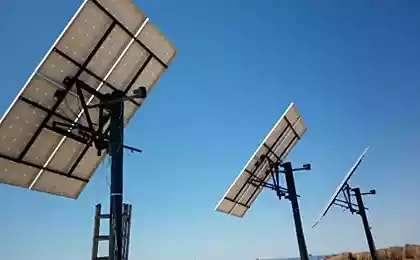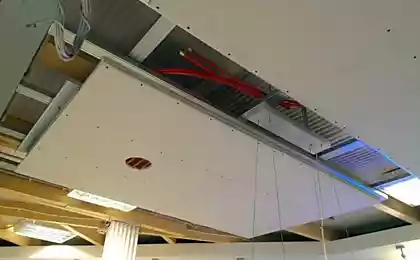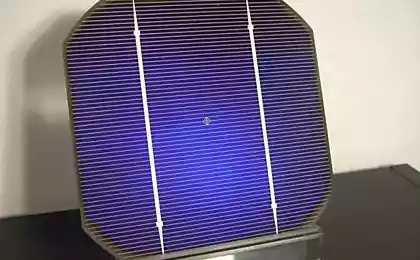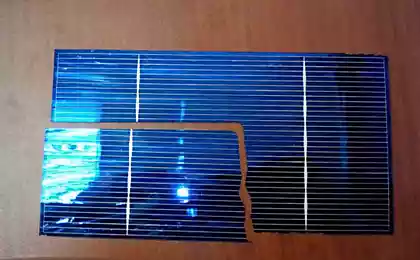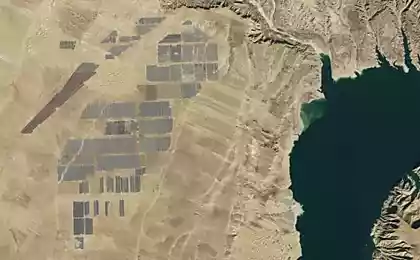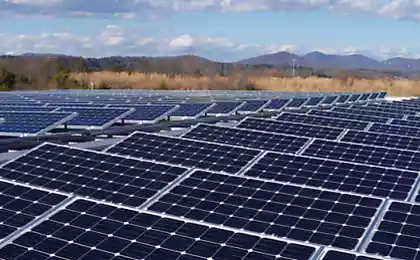649
The truth about solar panels
It's time to talk about how effective solar energy in the Moscow region. For a year I collected statistics to generate solar energy with two 100-watt solar panels installed on the roof of the cottage and connected to the network using a grid inverter. And now it's time to take stock.
Now you know what will never tell the sellers of the solar panels.
Exactly a year ago, in October 2015, as an experiment, I decided to join the ranks of "green", saving our planet from an untimely death, and purchased solar panels maximum power of 200 watt and grid-inverter has a maximum capacity of 300 (500) watt of generated power. In the picture you can see the structure of polycrystalline 200-watt panel, but after a couple of days after purchase it became clear that in single configuration it has too low voltage is insufficient for proper operation of my grid inverter.
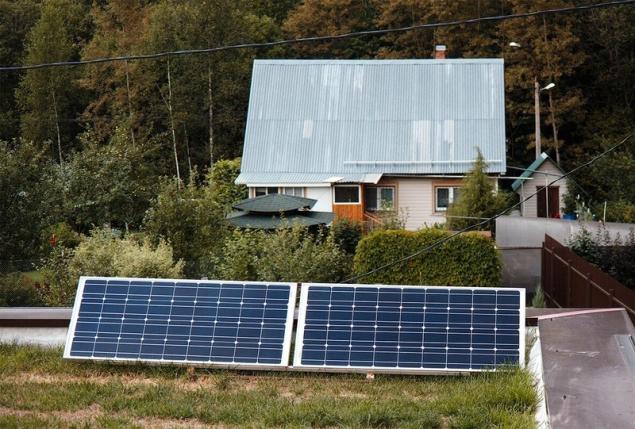
So I had to change it to two 100-watt monocrystalline panel. Theoretically they should be a little more efficient, in fact they just are more expensive. It panel high quality Russian brand Sunways. For two panels I paid 14 800 rubles.
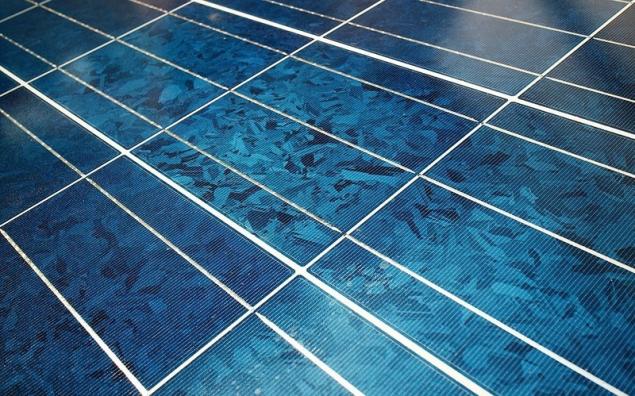
The second item of expenditure — grid inverter in China. Manufacturer not marked, but the device is well made, but the autopsy showed that the internal components are designed for power up to 500 watts (instead of 300, written on the body). There is such a grid of 5 000 rubles. Grid — this ingenious device. On the one hand is connected to the + and — from the solar panels, and on the other hand, he is using a conventional electric plug is connected completely into any electrical socket in your home. In the process, the grid adapts to the frequency and begins to "deflate" AC (converted from DC) to your homemade network 220 volts.
Grid only works in the presence of voltage in the network and can not be regarded as a backup power source. This is his only drawback. A huge advantage of the grid inverter is that you don't need batteries. After all, batteries are the weakest link in alternative energy. If the solar panel is guaranteed to work for more than 25 years (i.e. 25 years it would lose about 20% of its capacity), the lifespan of an ordinary lead battery in similar conditions will be 3-4 years. Gel and AGM batteries last longer, up to 10 years, but they are 5 times more expensive than conventional batteries.
Since I have mains electricty, I no batteries are not needed. If we do a system offline, you need to add to the budget of 15-20 thousand rubles for the battery and controller to it.

Now, as for power generation. All the energy generated by the solar panels in real time enters the network. If there are consumers of this energy, and it will be all spent, and the counter to enter the house to "spin" will not. If the instant power output will exceed consumption in the moment, all the energy will be transferred back to the network. That is, the meter will "spin" in the opposite direction. But there are nuances.
First, many modern electronic meters are considered pass-through current regardless of its direction (that is, you will have to pay for give back to the grid electricity). And secondly, the Russian legislation does not allow individuals to sell electricity. This is allowed in Europe and that is why there is every second house bedecked with solar panels, which together with high network tariffs can actually reduce.
What to do in Russia? Not to put solar panels that produce more energy than the current daily consumption in the house. For this reason, I only have two panels with a total capacity of 200 watts, which taking into account the losses of the inverter can give to the network about 160-170 watts. And my house is consistently around the clock consumes about 130-150 watts per hour. That is all generated by solar panels, the energy is guaranteed to be consumed inside the house.
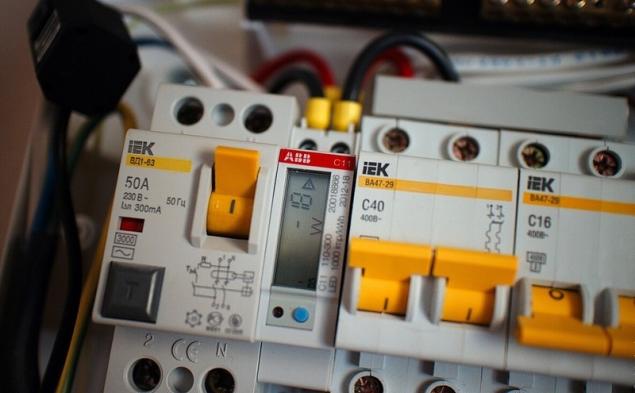
For control of produced and consumed energy I use Smappee. He has two current transformers, which allow a measurement of both network and generated by the solar panels of electricity.

Let's start with theory and move to practice.
The Internet has lots of calculators for solar power plants. My initial data according to the calculator, it follows that the average annual electricity production of my solar panels will be 0,66 kWh/day, and total production for the year — 239,9 kWh.
This data is for ideal weather conditions and without taking into account losses in converting DC to AC (you're not going to redo the electricity for your household at a constant voltage?). In reality, the resulting figure can safely divide by two.
Compare with real data on development during the year:
2015 the year of 5.84 kWh
October — of 2.96 kWh (from 10 Oct)
November is 1.5 kWh
In December of 1.38 kWh
2016 111,7 kWh
January — 0,75 kWh
February — of 5.28 kWh
March — 8,61 kWh
April — 14 kWh
May — of 19.74 kWh
June is 19.4 kWh
July — 17,1 kWh
August — 17,53 kWh
September — 7,52 kWh
October at 1.81 kWh (until October 10)
Total: 117,5 kWh
Here's a chart generation and consumption of electricity in a country house for the last 6 months (April-October 2016). For April-August, solar panels have been developed, the lion's share (over 70%) of electrical energy. In the remaining months of the year output was impossible mostly due to cloud cover and snow. Do not forget that the efficiency of the grid by converting DC to AC is approximately 60-65%.

Solar panels installed in almost ideal conditions. The direction is due South, not near tall buildings casting a shadow angle relative to the horizon — exactly 45 degrees. This angle will maximize annual energy production. Of course you could buy a swivel mechanism with the actuator and the function of tracking the sun, but this would have increased the budget of the entire installation by almost 2 times, thus pushing the term of its payback to infinity.
Solar energy in Sunny days I have no issues. It is fully consistent with design. And even a drop in production in winter, when the sun rises high above the horizon would not be so critical, if not... clear. It is the cloud is the main enemy of photovoltaics. Here you have hourly output two days: 5 and 6 October 2016. The fifth of October, the sun was shining, and on 6 October, the sky was covered with leaden clouds. Sun, ay! Where are you hiding?
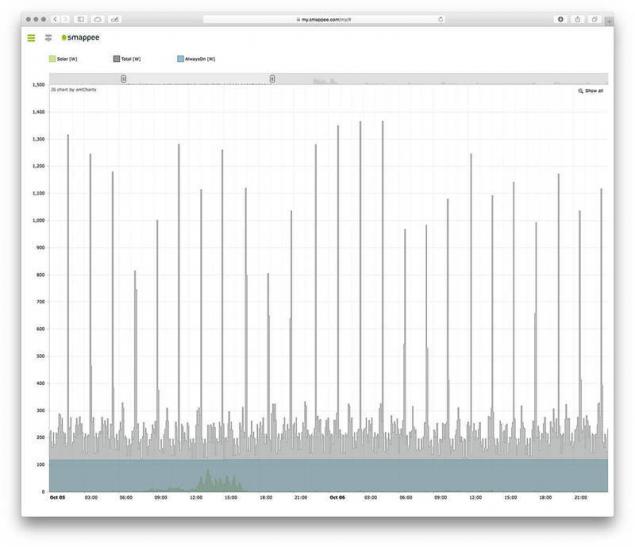
In winter, there is still one small problem — the snow. It can be solved in only one way, the panels to be installed almost vertically. Every day to manually clear them from snow. But the snow is nonsense, the main thing that the sun was shining. Even low on the horizon.
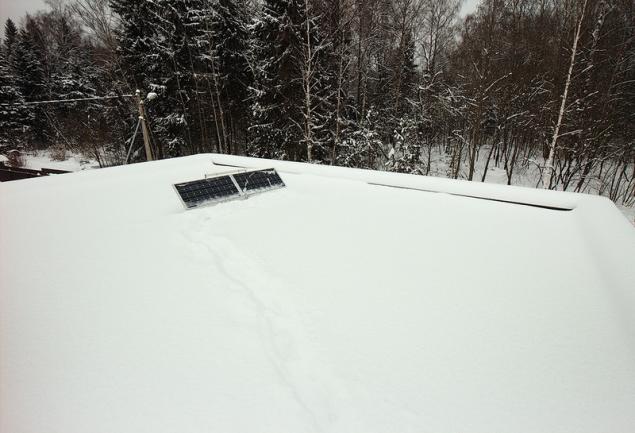
So, let's calculate the costs:
Grid inverter (300-500 watts) — 5 000 rubles
Monocrystalline solar panel (Grade A — highest quality) 2 PCs 100 watt — 14 800 rubles
Wire to connect solar panels (6 mm2) — 700 rubles
Total: 20 500 rubles.
Over the past reporting period was generated 117,5 kWh at the current day rate (of 5.53 rubles/kWh) is the amount of 650 rubles.
If we assume that the cost of network tariffs will not change (in fact they change in a big way 2 times a year), their investment in alternative energy I will be able to return only after 32 years!
And if you add batteries, the whole system will never pay for. Therefore, solar energy in the presence of mains electricity may be beneficial only in one case — when we have electricity it will cost in Europe. That will cost 1 kWh of mains electricity for more than 25 rubles, then solar panels will be very beneficial.
Meanwhile, the use of solar panels is beneficial only where there is no mains electricity and is too expensive. Suppose you have a country house, located 3-5 km away from the nearest electric lines. And it is high voltage (i.e., require the installation of the transformer), and you have no neighbors (no one to split the cost). That is for the network connection you will have to pay probation 500 000 rubles, and then another, and to pay network tariffs. In this case it would be profitable to buy with this amount of solar panels, controller and batteries — because once the system is in operation already more than you will not have to pay. published
Source: victorborisov.livejournal.com/283135.html#cutid1
Now you know what will never tell the sellers of the solar panels.
Exactly a year ago, in October 2015, as an experiment, I decided to join the ranks of "green", saving our planet from an untimely death, and purchased solar panels maximum power of 200 watt and grid-inverter has a maximum capacity of 300 (500) watt of generated power. In the picture you can see the structure of polycrystalline 200-watt panel, but after a couple of days after purchase it became clear that in single configuration it has too low voltage is insufficient for proper operation of my grid inverter.

So I had to change it to two 100-watt monocrystalline panel. Theoretically they should be a little more efficient, in fact they just are more expensive. It panel high quality Russian brand Sunways. For two panels I paid 14 800 rubles.

The second item of expenditure — grid inverter in China. Manufacturer not marked, but the device is well made, but the autopsy showed that the internal components are designed for power up to 500 watts (instead of 300, written on the body). There is such a grid of 5 000 rubles. Grid — this ingenious device. On the one hand is connected to the + and — from the solar panels, and on the other hand, he is using a conventional electric plug is connected completely into any electrical socket in your home. In the process, the grid adapts to the frequency and begins to "deflate" AC (converted from DC) to your homemade network 220 volts.
Grid only works in the presence of voltage in the network and can not be regarded as a backup power source. This is his only drawback. A huge advantage of the grid inverter is that you don't need batteries. After all, batteries are the weakest link in alternative energy. If the solar panel is guaranteed to work for more than 25 years (i.e. 25 years it would lose about 20% of its capacity), the lifespan of an ordinary lead battery in similar conditions will be 3-4 years. Gel and AGM batteries last longer, up to 10 years, but they are 5 times more expensive than conventional batteries.
Since I have mains electricty, I no batteries are not needed. If we do a system offline, you need to add to the budget of 15-20 thousand rubles for the battery and controller to it.

Now, as for power generation. All the energy generated by the solar panels in real time enters the network. If there are consumers of this energy, and it will be all spent, and the counter to enter the house to "spin" will not. If the instant power output will exceed consumption in the moment, all the energy will be transferred back to the network. That is, the meter will "spin" in the opposite direction. But there are nuances.
First, many modern electronic meters are considered pass-through current regardless of its direction (that is, you will have to pay for give back to the grid electricity). And secondly, the Russian legislation does not allow individuals to sell electricity. This is allowed in Europe and that is why there is every second house bedecked with solar panels, which together with high network tariffs can actually reduce.
What to do in Russia? Not to put solar panels that produce more energy than the current daily consumption in the house. For this reason, I only have two panels with a total capacity of 200 watts, which taking into account the losses of the inverter can give to the network about 160-170 watts. And my house is consistently around the clock consumes about 130-150 watts per hour. That is all generated by solar panels, the energy is guaranteed to be consumed inside the house.

For control of produced and consumed energy I use Smappee. He has two current transformers, which allow a measurement of both network and generated by the solar panels of electricity.

Let's start with theory and move to practice.
The Internet has lots of calculators for solar power plants. My initial data according to the calculator, it follows that the average annual electricity production of my solar panels will be 0,66 kWh/day, and total production for the year — 239,9 kWh.
This data is for ideal weather conditions and without taking into account losses in converting DC to AC (you're not going to redo the electricity for your household at a constant voltage?). In reality, the resulting figure can safely divide by two.
Compare with real data on development during the year:
2015 the year of 5.84 kWh
October — of 2.96 kWh (from 10 Oct)
November is 1.5 kWh
In December of 1.38 kWh
2016 111,7 kWh
January — 0,75 kWh
February — of 5.28 kWh
March — 8,61 kWh
April — 14 kWh
May — of 19.74 kWh
June is 19.4 kWh
July — 17,1 kWh
August — 17,53 kWh
September — 7,52 kWh
October at 1.81 kWh (until October 10)
Total: 117,5 kWh
Here's a chart generation and consumption of electricity in a country house for the last 6 months (April-October 2016). For April-August, solar panels have been developed, the lion's share (over 70%) of electrical energy. In the remaining months of the year output was impossible mostly due to cloud cover and snow. Do not forget that the efficiency of the grid by converting DC to AC is approximately 60-65%.

Solar panels installed in almost ideal conditions. The direction is due South, not near tall buildings casting a shadow angle relative to the horizon — exactly 45 degrees. This angle will maximize annual energy production. Of course you could buy a swivel mechanism with the actuator and the function of tracking the sun, but this would have increased the budget of the entire installation by almost 2 times, thus pushing the term of its payback to infinity.
Solar energy in Sunny days I have no issues. It is fully consistent with design. And even a drop in production in winter, when the sun rises high above the horizon would not be so critical, if not... clear. It is the cloud is the main enemy of photovoltaics. Here you have hourly output two days: 5 and 6 October 2016. The fifth of October, the sun was shining, and on 6 October, the sky was covered with leaden clouds. Sun, ay! Where are you hiding?

In winter, there is still one small problem — the snow. It can be solved in only one way, the panels to be installed almost vertically. Every day to manually clear them from snow. But the snow is nonsense, the main thing that the sun was shining. Even low on the horizon.

So, let's calculate the costs:
Grid inverter (300-500 watts) — 5 000 rubles
Monocrystalline solar panel (Grade A — highest quality) 2 PCs 100 watt — 14 800 rubles
Wire to connect solar panels (6 mm2) — 700 rubles
Total: 20 500 rubles.
Over the past reporting period was generated 117,5 kWh at the current day rate (of 5.53 rubles/kWh) is the amount of 650 rubles.
If we assume that the cost of network tariffs will not change (in fact they change in a big way 2 times a year), their investment in alternative energy I will be able to return only after 32 years!
And if you add batteries, the whole system will never pay for. Therefore, solar energy in the presence of mains electricity may be beneficial only in one case — when we have electricity it will cost in Europe. That will cost 1 kWh of mains electricity for more than 25 rubles, then solar panels will be very beneficial.
Meanwhile, the use of solar panels is beneficial only where there is no mains electricity and is too expensive. Suppose you have a country house, located 3-5 km away from the nearest electric lines. And it is high voltage (i.e., require the installation of the transformer), and you have no neighbors (no one to split the cost). That is for the network connection you will have to pay probation 500 000 rubles, and then another, and to pay network tariffs. In this case it would be profitable to buy with this amount of solar panels, controller and batteries — because once the system is in operation already more than you will not have to pay. published
Source: victorborisov.livejournal.com/283135.html#cutid1
Healthy spine exercises to increase mobility
Obstetrician Michel odent: the more tests, losing pregnant, the more cause for anxiety



